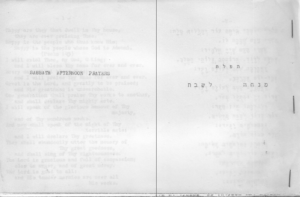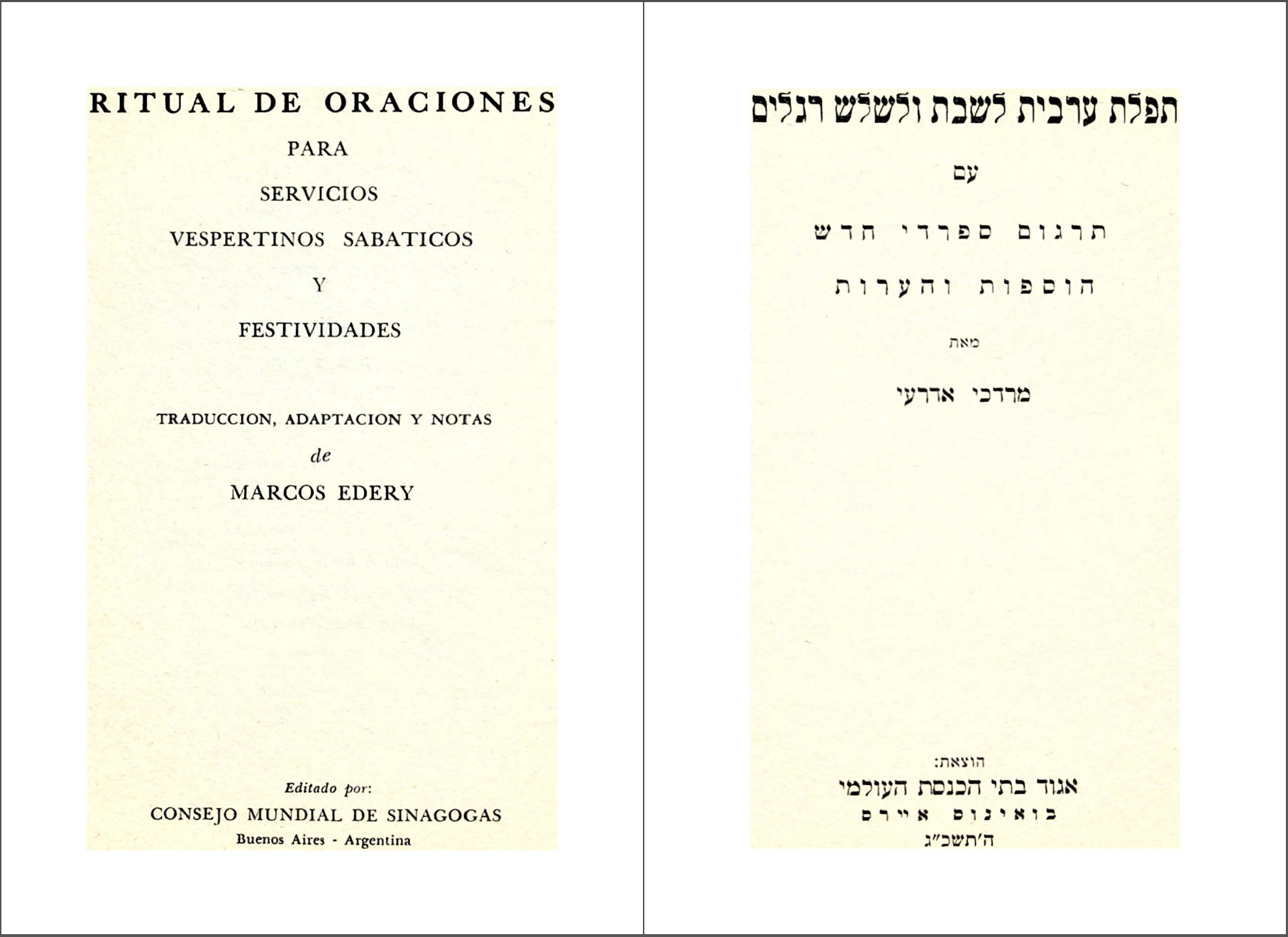Source

| Source (Hebrew) | Source (English) |
|---|---|
חוברת הפלות זו נועדה בראש ובראשונה לחוגם של תלמודי בית המדרש לרבנים בסינסינאטי המתאספים מדי שבת בשבתו ללימוד מקורות היהדות – מחוץ למסגרת הרשמית של תכנית המוסד, ז.א. ללימוד התורה “לשמה”. כדאי איפוא להתחיל אסיפות שבת אלו בתפלת ״מנחה לשבת״, ולשם כך חוברה חוברת זו. |
This prayer-leaflet is primarily intended for a group of Hebrew Union College students who meet every sabbath afternoon for extra-curricular (noncredit) Torah study. It is fitting, therefore, that their weekly gatherings should begin with the Sabbath Minḥah Service; and it was for that purpose that this leaflet was compiled. |
החפלה נאמרה כולה בלשון הקדש וב״נוסח המסורתי. השמטנו רק את החזרות (למשל, רק אמירה אחת של ה”עמידה”, ו”קדושה” רק בתוך ה”עמידה” ולא ב”ובא לציון גואל” ואת הבקשה לחידוש עבודת הקרבנות (אבל לא וותרנו על מקומה של ציון כסמל התקוה המשיחית); והעדפנו אה הצורה החיובית על הצורה השלילית להביע את רעיון ה”בחירה” ב”עלינו לשבח”. |
The service is conducted entirely in Hebrew and in the traditional nusaḥ. We have omitted only the various repetitions as well as the prayer for the restoration of the sacrificial service. (But we have retained the place of Ẓion as the symbol of the messianic hope.) In the ‘Alenu prayer, we have preferred a positive formulation of the “Election of Israel” to the traditional negative one. |
התרגום האנגלי אינו מתאמר להיות תרגום מלולי. אמנם, קטעים מן התנ״ך תורגמו באופן מלולי, ופה ושם גיתן גם תרגום מלולי לכמה תפלות. אלא על־פי־רוב לא השתדלנו “לתרגם” את התפלות מכל וכל. במקום תרגום נסינו לתאר את תוכנן של התפלות ואת משמעותן כפי שמשמעויות אלו מורגשות בלבו של יהודי בעת החדשה ובסביבה המערבית. הקונקרטיות הקלסית של החומר המסורתי במקומה מונחת – בנוסח העברעי שבו משתמשים לצורך התפלה, ואילו לא תמיד הולמת קונקרטיות זו אה בנין הלשון ואת דרכי המחשבה באנגלית. |
The English translation does not claim to be literal. While a literal translation has been given of Scripture passages and of a few of the prayers, we have, in many cases, not attempted a “translation” at all. Instead of a translation, we have endeavored to describe the contents of the prayers and the meaning which they could have for the modern Jew in the Western world. The classical concreteness of the traditional material has been retained in the Hebrew text which is being used for worship. But it must be admitted that this concreteness does not always lend itself to literal translation when it comes to English sentence structure and ways of thought. |
פראנץ רוזנצווייג ז״ל הדגיש את האוירה “המשיחית” של “תפלת מנחה לשבתי”. כשם שתפלת ערבית לשבה מדברת על האמונה בבריאת העולם (“אתה קדשת”), וכשם שתפלת שחרית לשבת מדברת על האמונה בהתגלות האל (“ישמח משה”), כך מתרכזת בתפלת המנחה האמונה בימוח-המשיח, היות ומדובר בה על “אתה אחד ושמף אחד”, ז.א. ע״ד קיום הנבואה ש”ביום ההוא יהיה ה’ אחד ושמר אחד”. מיום השבת שבבל שבוע ושבוע נודף ריחה של אותה תקופה שהיא “יום שכולו שבת ומנוחה לחיי העולמים.” |
It was the late Franz Rosenzweig who stressed the “messianic” atmosphere of the Sabbath Afternoon Service. The Friday Evening Service deals with the belief in Creation. The Sabbath Morning Service speaks of Revelation. It is the Sabbath Afternoon Service in which the belief in Redemption is concentrated. Here, the central section of the ‘Amida says: “Thou art One, and Thy Name Is One” – a clear reference to “that day” when, according to the Prophet, “the Lord shall be One, and His Name One.” The weekly sabbath is meant to give us the flavor of that age which will be “a day that is altogether sabbath and rest in the life of the world to come.” |
תפקידה של חוברה זו הוא לעורר את הרגישות לריח זה בלבם של הצעירים המתכוננים להוראה בקרב יהדות ארצה״ב. |
It is the task of this leaflet to arouse an appreciation of that “flavor” among those who are preparing themselves for rabbinical leadership in American Judaism. |
יום ד׳ באייר, תשכ״ו. י.י.פ. |
Iyyar 4th, 5726. [April 24th, 1966] J.J.P. |

“📖 תפלת מנחה לשבת | Shabbat Minḥah Prayers, a prayer-pamphlet by Dr. Jakob J. Petuchowski (1966)” is shared through the Open Siddur Project with a Creative Commons Attribution-ShareAlike 4.0 International copyleft license.









